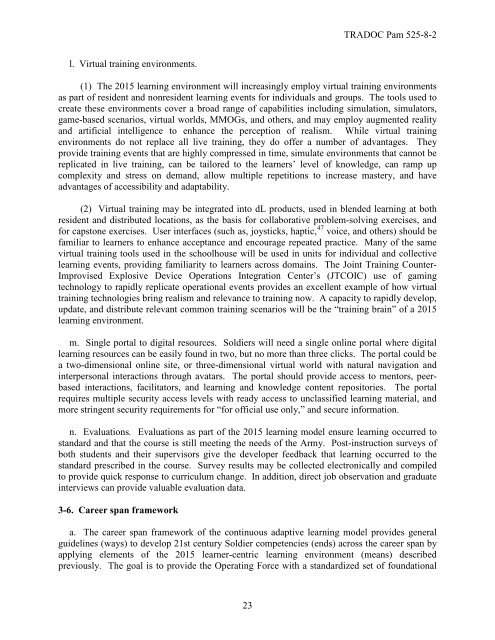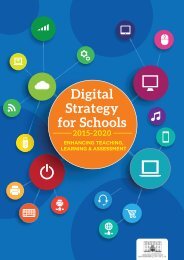K3zgZ
K3zgZ
K3zgZ
Create successful ePaper yourself
Turn your PDF publications into a flip-book with our unique Google optimized e-Paper software.
TRADOC Pam 525-8-2<br />
l. Virtual training environments.<br />
(1) The 2015 learning environment will increasingly employ virtual training environments<br />
as part of resident and nonresident learning events for individuals and groups. The tools used to<br />
create these environments cover a broad range of capabilities including simulation, simulators,<br />
game-based scenarios, virtual worlds, MMOGs, and others, and may employ augmented reality<br />
and artificial intelligence to enhance the perception of realism. While virtual training<br />
environments do not replace all live training, they do offer a number of advantages. They<br />
provide training events that are highly compressed in time, simulate environments that cannot be<br />
replicated in live training, can be tailored to the learners’ level of knowledge, can ramp up<br />
complexity and stress on demand, allow multiple repetitions to increase mastery, and have<br />
advantages of accessibility and adaptability.<br />
(2) Virtual training may be integrated into dL products, used in blended learning at both<br />
resident and distributed locations, as the basis for collaborative problem-solving exercises, and<br />
for capstone exercises. User interfaces (such as, joysticks, haptic, 47 voice, and others) should be<br />
familiar to learners to enhance acceptance and encourage repeated practice. Many of the same<br />
virtual training tools used in the schoolhouse will be used in units for individual and collective<br />
learning events, providing familiarity to learners across domains. The Joint Training Counter-<br />
Improvised Explosive Device Operations Integration Center’s (JTCOIC) use of gaming<br />
technology to rapidly replicate operational events provides an excellent example of how virtual<br />
training technologies bring realism and relevance to training now. A capacity to rapidly develop,<br />
update, and distribute relevant common training scenarios will be the “training brain” of a 2015<br />
learning environment.<br />
m. Single portal to digital resources. Soldiers will need a single online portal where digital<br />
learning resources can be easily found in two, but no more than three clicks. The portal could be<br />
a two-dimensional online site, or three-dimensional virtual world with natural navigation and<br />
interpersonal interactions through avatars. The portal should provide access to mentors, peerbased<br />
interactions, facilitators, and learning and knowledge content repositories. The portal<br />
requires multiple security access levels with ready access to unclassified learning material, and<br />
more stringent security requirements for “for official use only,” and secure information.<br />
n. Evaluations. Evaluations as part of the 2015 learning model ensure learning occurred to<br />
standard and that the course is still meeting the needs of the Army. Post-instruction surveys of<br />
both students and their supervisors give the developer feedback that learning occurred to the<br />
standard prescribed in the course. Survey results may be collected electronically and compiled<br />
to provide quick response to curriculum change. In addition, direct job observation and graduate<br />
interviews can provide valuable evaluation data.<br />
3-6. Career span framework<br />
a. The career span framework of the continuous adaptive learning model provides general<br />
guidelines (ways) to develop 21st century Soldier competencies (ends) across the career span by<br />
applying elements of the 2015 learner-centric learning environment (means) described<br />
previously. The goal is to provide the Operating Force with a standardized set of foundational<br />
23




